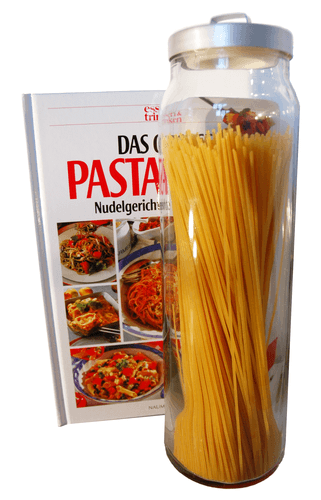About Pasta
Pasta is a type of noodle and is a staple food of traditional Italian cuisine, with the first reference dating to 1154 in Sicily. It is also commonly used to refer to the variety of pasta dishes. Typically pasta is made from an unleavened dough of a durum wheat flour mixed with water and formed into sheets or various shapes, then cooked and served in any number of dishes. It can be made with flour from other cereals or grains, and eggs may be used instead of water. Pastas may be divided into two broad categories, dried (pasta secca) and fresh (pasta fresca). Read More
Pasta is a type of noodle and is a staple food of traditional Italian cuisine, with the first reference dating to 1154 in Sicily. It is also commonly used to refer to the variety of pasta dishes. Typically pasta is made from an unleavened dough of a durum wheat flour mixed with water and formed into sheets or various shapes, then cooked and served in any number of dishes. It can be made with flour from other cereals or grains, and eggs may be used instead of water. Pastas may be divided into two broad categories, dried (pasta secca) and fresh (pasta fresca). Chicken eggs frequently dominate as the source of the liquid component in fresh pasta. Most dried pasta is commercially produced via an extrusion process. Fresh pasta was traditionally produced by hand, sometimes with the aid of simple machines, but today many varieties of fresh pasta are also commercially produced by large scale machines, and the products are broadly available in supermarkets. Both dried and fresh pasta come in a number of shapes and varieties, with 310 specific forms known variably by over 1300 names having been recently documented. In Italy the names of specific pasta shapes or types often vary with locale. For example the form cavatelli is known by 28 different names depending on region and town. Common forms of pasta include long shapes, short shapes, tubes, flat shapes and sheets, miniature soup shapes, filled or stuffed, and specialty or decorative shapes. As a category in Italian cuisine, both dried and fresh pastas are classically used in one of three kinds of prepared dishes. As pasta asciutta (or pastasciutta) cooked pasta is plated and served with a complementary sauce or condiment. A second classification of pasta dishes is pasta in brodo in which the pasta is part of a soup-type dish. A third category is pasta al forno in which the pasta incorporated into a dish that is subsequently baked. Pasta is generally a simple dish, but comes in large varieties because it is a versatile food item. Some pasta dishes are served as a first course in Italy because the portion sizes are small and simple. The servings are usually accompanied by a side of meat. Pasta is also prepared in light lunches, such as salads or large portion sizes for dinner. It can be prepared by hand or food processor and served hot or cold. Pasta sauces vary in taste, color and texture. When choosing which type of pasta and sauce to serve together, there is a general rule that must be observed. Simple sauces like pesto are ideal for long and thin strands of pasta while tomato sauce combines well with thicker pastas. Thicker and chunkier sauces have the better ability to cling onto the holes and cuts of short, tubular, twisted pastas. Sauce should be served equally with its pasta. It is important that the sauce does not overflow the pasta. The extra sauce is left on the plate after all of the pasta is eaten.

